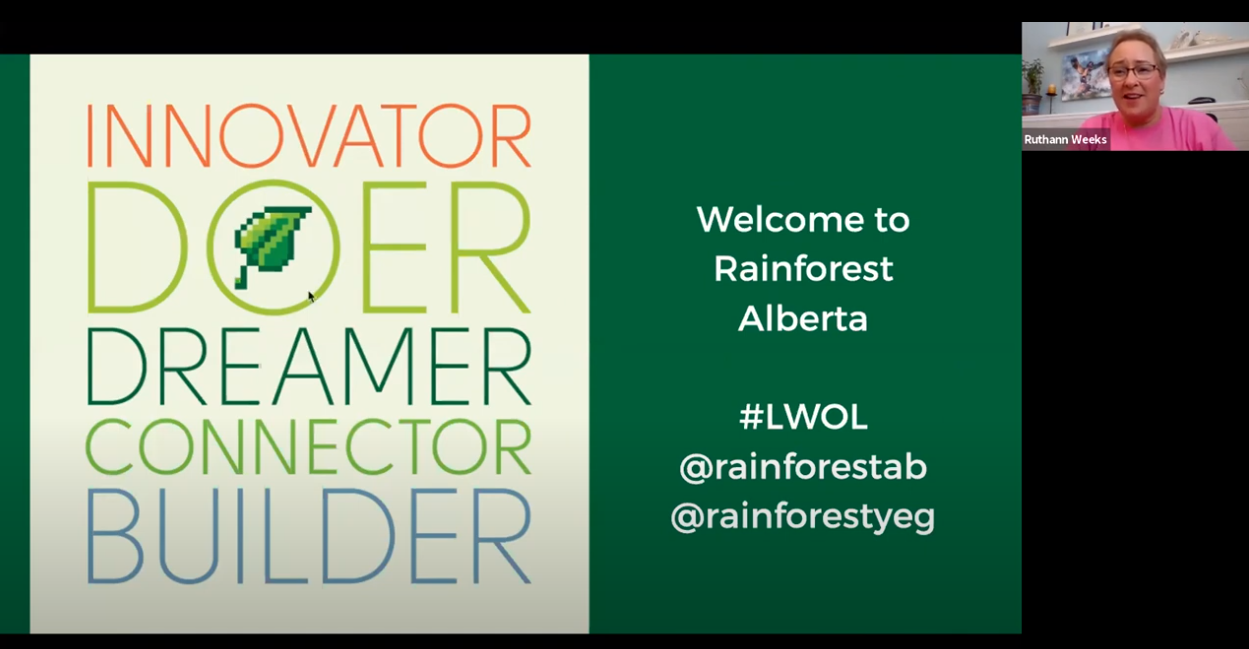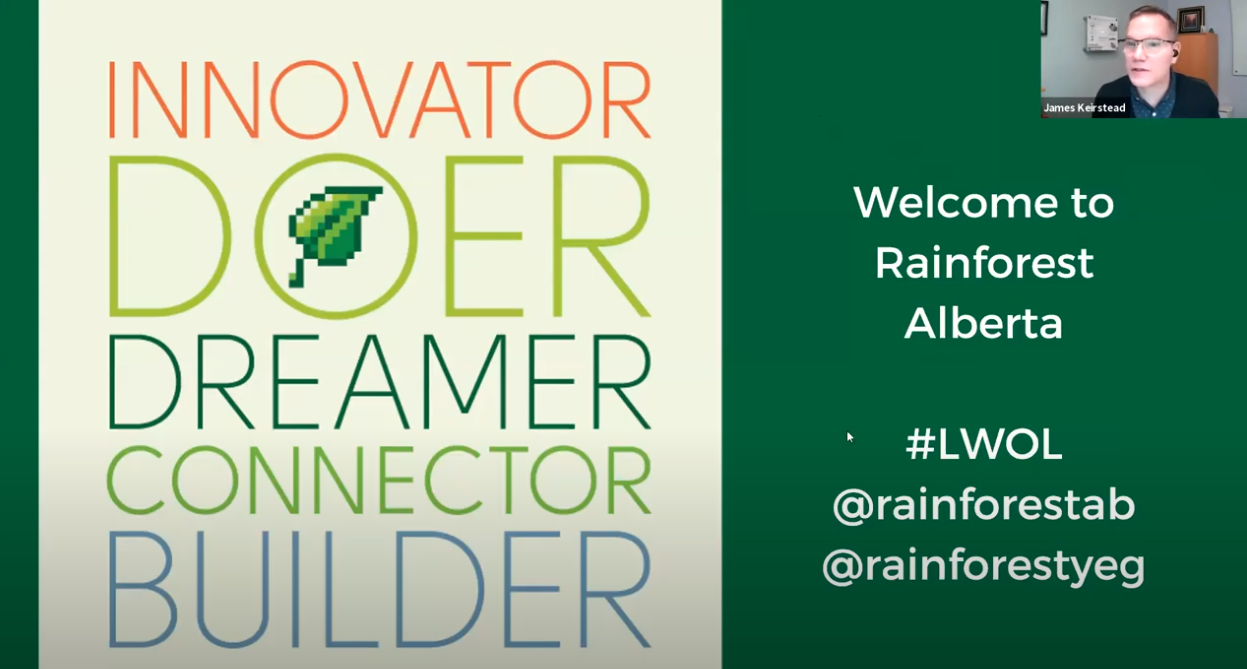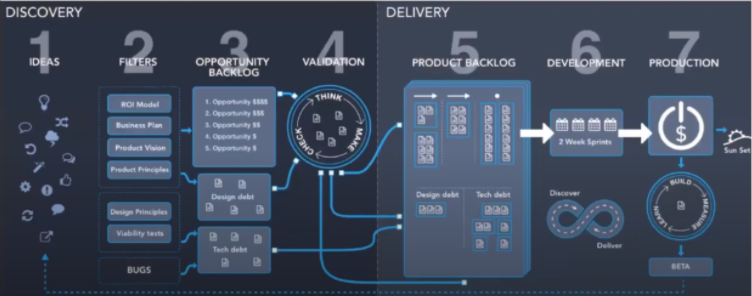|
This week’s LWOL featured a discussion about the importance of Corporate Governance in startups. You can watch the full recording here and the comment log is available on our Slack channel. The session was hosted by Calgary Community Manager Brigitte and Co-Hosted by Edmonton's Steering Committee Member and Entrepreneur Ruthann! This happened to also be anti-bullying awareness day and Ruthann was showing her support with a pink shirt; she's always a champion for great causes! SpeakersMichael Robinson Professor of Entrepreneurial Finance at the U of C and is the Academic Director for CDL Rockies. Melanie McClare CEO of Swirlex, and an MBA graduate from the Haskayne School of Business. Conversation NotesThe Rainforest is all about taking risks and learning new ideas and concepts, so take a risk and learn something new today!
1 Comment
This week’s LWOL featured Product Calgary and a discussion about Product Management. You can watch the full recording here and the comment log is available on our Slack channel. The session was hosted by Calgary Community Manager Brigitte and Co-Hosted by Edmonton's Steering Committee Chair and Entrepreneur James! SpeakersMartin L’Heureux - Panel Host Martin is a co-founder of Product Calgary and started his career as a developer with a taste for strategy who moved into business analysis and later product management. He has a passion for understanding customer needs that powers his teams to deliver extraordinary experiences. Christa Hill Christa is VP of Product at Morgan Stanley where she works with FinTech’s and Non-Profits. Ali York Ali is the Product Management Lead at 7Shifts, a startup that helps restaurant owners manage their shift scheduling. Miche Priest Miche started her product management career at Alta ML but recently joined Sylvester AI as their Venture Lead. They use machine learning to help identify pain in felines using facial recognition. Conversation HighlightsNote: We’ll us the abbreviation PM to refer to the career of Product Management, the action of Managing a Product, and the individual with the job title Product Manager. If this isn’t clear enough in context, we’ll write it out. What is Product Management NOT?
What’s the advice to a founder thinking of hiring a PM?
This post is an aggregation of year in review posts we've made in the past. Read on to see where Rainforest has been and how we've evolved over time in Edmonton!
Orignally shared in the Rainforest Pulse in September 2018, the following post discusses how innovation requires teamwork to make the dream work. The importance of Teamwork in the Innovation ProcessInnovation is not a brilliant idea; it is a process. A brilliant idea becomes an innovation when it is monetized into a product or system that produces significantly improved results for an end-user or customer. The process of innovation takes an idea from a thought, to a commercialized product.
Many organizations fail at innovation because leaders don't understand that innovation is a multi-step process, and the talents required at each step of the process are very different. For innovation to succeed, it needs to be a team-based process. In the book The Rainforest: The Secret to Building the Next Silicon Valley, authors Hwang and Horowitt describe innovation as "body contact sport". Like any sport, a team wins or losses based on the actions of the individual members, each specialized for their role, and how well they act together towards a shared outcome. Similarly for innovation, where commercialization of an idea requires individuals from diverse backgrounds and with unique skillsets who together can create something greater than themselves. The researcher cannot succeed without the marketing expert, the sales expert, the human resources experts, nor the customer service experts. Orignally shared in the Rainforest Pulse in August 2018, the following post discusses the value of Honesty when challening the norm. The importance of Honesty in the Innovation Process"If I make deposits into an Emotional Bank Account with you through courtesy, kindness, honesty, and keeping my commitments to you, I build up a reserve. Your trust toward me becomes higher, and I can call upon that trust many times if I need to. I can even make mistakes and that trust level, that emotional reserve, will compensate for it. My communication may not be clear, but you'll get my meaning anyway. You won't make me "an offender for a word." When the trust account is high, communication is easy, instant, and effective." - Stephen Covey Technology has created a more global, connected world. This has lead to ever shrinking geographical distances, increasing the opportunity for innovation. At the same time, humans have not developed the skills necessary to deal with the vast social distances between communities and cultures. Innovators, though more connected, have a more difficult time building trust and collaborating.
Rainforest focuses on bringing together people who are different, unlike traditional clusters that focus on bringing together people who are similar. This is necessary to bridge these social distances, by encouraging interactions of diverse thoughts and disciplines. This is built upon trust that can only happen when all individuals are open and honest. After all, a business person and an academic might be the perfect fit "on paper", able to bring more value to a partnership than either could accomplish alone, but without honest dialogue, trust, and transparency, neither can achieve these benefits. Orignally shared in the Rainforest Pulse in July 2018, the following post discusses the value of Paying it Forward when building innovation ecosystems. Why is Listening so important to Innovation in Alberta?Listening is a fundamental interpersonal skill; without it, communication is at best superficial. In the context o innovation, listening is a crucial skill. Adept listeners ask questions like "what problem are we really solving", "is this the right problem to be solving", or "what are the possible unintended consequences of our proposed solution", and they actively listen, rather than cosmetically listen, to the answer. Listening can generate real change, produce unexpected outcome, and foster real innovation. There are 5 levels of listening, the lowest level being cosmetic listening and the highest level being emergent listening. Members of the Rainforest practice at least Empathetic listening - that is they listen to understand, not simply to respond.
"Connecting to the emerging future – to a future possibility that links to your emerging self; to who you really are." - Otto Scharmer, Presencing Institute To master the art of listening to understand, try these tips:
Covey first recommends taking time to listen to yourself and understand your own core goals and values. This is a necessary step to as it allows you to consult your own values and goals before acting. Next, Covey recommends listening to others in order to become aware of the values and goals of others. This enables you to find common ground and thus maintain productive relationships. Habit 5 - Seek First to Understand is built upon empathetic listening, a skill Covey considers essential to effective communication. Covey emphasizes the power of going beyond mechanical responses of conversational listening but to instead feel what the speaker is feeling. Covey, as others, believes that the only way to establish communication in some professional and personal situations is by becoming, in small part, the person you are listening to. We are all capable of seeing the world through the eyes of another, but most of us do not deliberately try to do so. Covey notes that it takes time and practice to learn this skill, but the reward is a whole new level of communication and problem solving. By acquiring the ability to see a situation simultaneously from multiple points of view, members of the Rainforest are able to truly innovate but truly understanding the needs of their end users, customers, or supply-chain. Orignally shared in the Rainforest Pulse in June 2018, the following post discusses the value of Paying it Forward when building innovation ecosystems. Why is Fairness so important to Innovation in Alberta?Fairness is foundational to the Rainforest. When individuals listen and are open-minded to ideas, experiences, and perspectives of others it breaks down barriers. When people feel they have been treated fairly, they are less fearful, suspicious and more motivated to collaborate. In the Rainforest, Fairness is exemplified though a Positive Sum or Win-Win mindset, rather than a Zero Sum or Win-Lose mindset.
The Zero Sum mindset approaches negotiations or business transactions from a fixed-pie perspective; that is to increase the share of one, someone else must give something up. In an innovation mindset, individuals seek to increase value, knowing they can achieve more by working together. Not all situations are positive sum, but by embracing the value of fairness, members of the Rainforest seek first to add value for all, before deriving benefit for themself. You may be wondering how you can embrace the value of Fairness and a Positive Sum mindset? Consider the book 7 Habits of Highly Effective People by Stephen Covey. One of Covey's 7 Habits is Think Win-Win. He says: “Think Win-Win isn’t about being nice, nor is it a quick-fix technique. It is a character-based code for human interaction and collaboration.Many people think in terms of either/or: either you’re nice or you’re tough. Win-win requires that you be both. It is a balancing act between courage and consideration. To go for win-win, you not only have to be empathic, you also must be confident. You not only have to be considerate and sensitive, you also must be brave. To do that–to achieve that balance between courage and consideration–is the essence of real maturity and is fundamental to win-win.” Orignally shared in the Rainforest Alberta Pulse in May 2018, the following post discusses the value of Paying it Forward when building innovation ecosystems. Why is Paying It Forward so important to Innovation in Alberta?One of the fundamental rules of the Rainforest is the concept of "paying it forward", that is to do something for another without expecting to be paid back directly. This attitude of giving before receiving is at the heart of a strong and vibrant community of any type, and core to the Rainforest in general.
Paying it forward begins with authenticity. To do something for the benefit of another, while truly not expecting to receive anything in return, one must be authentic and honest about their intentions. Individuals who Pay It forward truly understand that value given is value added. At an ecosystem level, in a world of competition and amid the hustle and bustle of surviving day-to-day, finding time to Pay It Forward may be difficult, counter-intuitive even, but to be a leader, in any context, means adding value. The idea of Paying It Forward can manifest in the simplest of ways, from holding a door open for another person to buying coffee to the person in line behind you. These simple acts of kindness are valuable, just as is there value in letting a new entrepreneur bounce an idea off you, to learn from your experience. John Maxwell said it best,” People don’t care how much you know until they know how much you care.” Maybe the words of Winston Churchill have more weight: "We make a living by what we get. We make a life by what we give.” It is this spirit of Paying It Forward that makes Silicon Valley, and other Rainforest such hubs for innovation. Alberta is much like Silicon Valley in this way. People here are open, friendly, and neighborly. Indeed, it is often said that it is possible to arrange a meeting with nearly anyone in Alberta if you know who you want to talk to. It is this level of access that has made silicon valley, and other Rainforests, so successful. This willingness to help out and uplift others is what makes communities such as those in Silicon Valley, or Alberta, so strong, resilient, and capable of greatness. How can you Pay It Forward? As a successful entrepreneur, you can make yourself available to mentor or coach someone starting their entrepreneurial journey. Participate in one of the many mentorship programs in Alberta such as VMS, Raj Manek, or Futurepreneur. Come out to an event and make yourself available to answer questions. Reach out to exciting new startups, or scaling ventures and join their advisory panel. Share your experience as an entrepreneur with government, at all levels, so that they can design and fund programs that meet your needs. Volunteer with one of the hundreds of charities, non-profits, or grassroots initiatives across the province. Make an introduction. Invest. In a Rainforest, it pays to be open-minded to new people, to be helpful, and to treat each person as though they might have the next valuable opportunity. Orignally shared in the Rainforest Alberta Pulse in April 2018, the following post discusses the value of Diversity to cultivating and supporting Innovators. How does a culture of TRUST benefit the Alberta Innovation?Trust is probably the most important value in the Rainforest. Not only is this value key to driving the internal success of a company, but trust is the social lubricant that allows positive-sum deals to be made, allows diverse collaborations to begin, and the freedom to share ideas and openly discuss customer-centric problems.
Trust is also central to enabling potential customers to adopt a new or unknown technology or product from a company that may not have existed in the near past. Trust, having obvious advantages, remains elusive. As advances in communications and travel have decreased the apparent size of the world, making enormous geographical distances easy to traverse, the inhibitors to innovation, collaboration, and trust quickly have shifted to social barriers. It is easier now, much more than ever, to connect with individuals or groups anywhere in the world, at almost no cost. These advances have amplified the connections within similar social circles. For example, academics in a given field can collaborate more easily than ever before, working side by side on a research project while being thousands of kilometres apart. Despite these advances, disparate social circles trust each other less than ever before. Academics, for example, have similar values, beliefs, and speak a common language among themselves, as do other groups such as business people, artists, etc. Technology has made it easier to share information within these groups, reinforcing the common beliefs and amplifying the existing messages. What is needed in this evolving world is more trust between social groups. Business people, working with artists, working with academia, and others, to achieve results of common interest, bringing new innovations to market and generating real economic value. Trust is the lubricant that makes these diverse collaborations possible, and this is why trust is a key value of the Rainforest. Breaking outside your circle of trust requires embracing discomfort, which is not easy for most people. In the book "The Rainforest: The Secret to Building the Next Silicon Valley", authors Hwang and Horowitt discuss an unusual individual that they call a Keystone. Keystones are described as individuals practicing a certain manner of human interaction that is critical to the growth of entrepreneurial innovation. They "have the effect of lowering the cost of doing business in the Rainforest, speeding up the process of interactions in the entire system, and making it easier for people with ideas, talent, or captial to connect and collaborate with each other." Hwang and Horowitt describe the key attributes of Keystones, which are essential to the success of an innovation ecosystem:
Orignally shared in the Rainforest Alberta Pulse in March 2018, the following post discusses the value of Diversity to cultivating and supporting Innovators. How does access to Free Help benefit the invisible innovation infrastructure?Nothing in life is truly free. That is why we are so blessed to have experienced entrepreneurs, service providers, and investors in the Alberta Innovation Ecosystem who are willing and able to provide the benefit of their time and knowledge to help emerging and aspiring entrepreneurs.
The investment of time and knowledge doesn't just come from the experienced individuals in the ecosystem either. Those seeking help, collaborators, or new ideas need to put in the effort to attend events, embrace collisions with new people, and be open to both sharing their ideas and asking for help or advice. In the book "The Rainforest: The Secret to Building the Next Silicon Valley", authors Hwang and Horowitt discuss how to measure the velocity of innovation in an ecosystem (the speed with which innovation happens). This 'heartbeat' can be measured through a variety of proxies such as Diversity, Extra-Rational Motivation, Social Trust, and Interpretation of Rules within the System (the Social Contract). Receiving and providing help, without expecting anything in return, is an example of individuals within the innovation ecosystem acting with a greater purpose, or extra-rational motivation. It is this motivation to help others that defines the culture of the Rainforest. As James Keirstead often says, "all boats rise with the tide". When individuals take it upon themselves to find or provide help to each other, the tide will rise, and everyone benefits. The tide rises not only by providing free help, but by freely sharing ideas, introductions to resources, advice, and more. This is why the Rainforest acts to bring all aspects of the innovation ecosystem together on a regular basis. By creating collisions, encouraging the sharing of ideas, needs, and capability to give back, we increase the velocity of trust building, resulting in an increased rate of innovation in Alberta. |
AuthorWrite something about yourself. No need to be fancy, just an overview. Archives
September 2021
Categories |





 RSS Feed
RSS Feed
